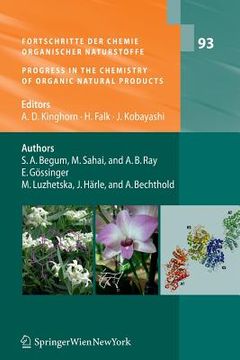Compartir
fortschritte der chemie organischer naturstoffe / progress in the chemistry of organic natural products, vol. 93 (en Inglés)
Mahendra Sahai
(Autor)
·
A. Douglas Kinghorn
(Ilustrado por)
·
Heinz Falk
(Ilustrado por)
·
Springer
· Tapa Blanda
fortschritte der chemie organischer naturstoffe / progress in the chemistry of organic natural products, vol. 93 (en Inglés) - Kinghorn, A. Douglas ; Sahai, Mahendra ; Falk, Heinz
$ 253.410
$ 506.810
Ahorras: $ 253.400
Elige la lista en la que quieres agregar tu producto o crea una nueva lista
✓ Producto agregado correctamente a la lista de deseos.
Ir a Mis Listas
Origen: Estados Unidos
(Costos de importación incluídos en el precio)
Se enviará desde nuestra bodega entre el
Jueves 11 de Julio y el
Jueves 18 de Julio.
Lo recibirás en cualquier lugar de Chile entre 1 y 3 días hábiles luego del envío.
Reseña del libro "fortschritte der chemie organischer naturstoffe / progress in the chemistry of organic natural products, vol. 93 (en Inglés)"
Lignans, by convention, are a group of natural products that are formed by linking two phenylpropanoid units (C C units) by oxidative coupling. Most importantly, in 6 3 a lignan, two (C C units) are bound through the central carbon of their side chains, 6 3 0 i. e. the 8 and 8 positions (1, 2). The occurrence of C C -dimers, linked at sites other 6 3 0 than the 8-8 positions, is also known and these compounds have been termed neolignans (3, 4). As these two groups of compounds have close structural as well as biosynthetic relationships, they are often associated together and incorporated under the general term "lignan" (5). The diverse structural categorization of true lignans and of a few neolignans is presented in Fig. 1. Through the years, several review articles or books covering different facets of lignans, including their ch- istry (6, 7), biogenesis (8), synthesis (9), and biological activities (10) have been published. Enduring research for the investigation of secondary metabolites of plants has evidenced some compounds that are biogenetically related to true lignans or neolignans but bear some features not discerned in conventional lignans. These compounds or groups of compounds have been termed as "non-conventional lignans", and include coumarinolignans, ?avonolignans, and stilbenolignans. The non-conventional lignans, like the conventional ones, have two C C units linked 6 3 together but have additional structural features to place them also under the category of coumarins, ?avonoids, or stilbenes.

